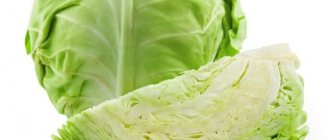By the age of six months, the nutrition that the baby receives in the form of mother’s milk or an adapted formula becomes insufficient for all the needs of the grown-up toddler. The time is coming to get acquainted with new food, that is, complementary foods. Let's look at what new foods you can give your six-month-old baby to try.
What foods can you already eat?
Six months is the right time for the first feeding of a baby who was previously exclusively breastfed. The toddler’s gastrointestinal tract is already ready to taste vegetables, cereals and fruits.
Parents should decide together with their pediatrician which product to introduce first. Babies who are gaining weight poorly are recommended to start with cereals, and well-fed babies with frequent constipation should start complementary feeding with vegetable dishes. Check out the table for introducing complementary foods when breastfeeding.
After introducing complementary foods at 6 months, breast milk or formula will still remain the main thing in the baby’s diet
Please note the following:
- Vegetables are given in the form of puree from one type of vegetable, offering the baby 5 grams for the first time. Next, the portion is carefully increased to the age-appropriate dosage - 100 grams per day. When the baby has become accustomed to one vegetable, they begin to offer him a second type of vegetable, again starting with 5 grams.
- Porridge at 6 months of age is prepared without milk, but can be diluted with human milk or formula. The first portion of porridge will be 10 grams, after which the total amount of porridge eaten per day is increased to 150 grams.
- Babies who are accustomed to vegetables and cereals begin to offer fruits. They are also given in the form of a one-component puree - first 5 grams for the first sample, and then every day more up to a daily dose of 30 grams.
There are also many supporters of using fermented milk products for first complementary feeding. Among them is the famous pediatrician Komarovsky. A popular doctor recommends starting to give kefir to a healthy 6-month-old baby. The product is offered during the second feeding, gradually increasing the portion to 160 ml. From the fifth day of introducing kefir into the baby’s diet, Komarovsky advises starting to add cottage cheese to it. Its daily portion for a 6-month-old baby is 30 g. Read more about introducing complementary foods according to Komarovsky in another article.
In situations where the mother does not have enough breast milk or is not able to feed the baby with an adapted formula, introduction to vegetables and cereals is postponed to an earlier date - 4-5 months (we recommend following our table for introducing complementary foods when artificial feeding). Artificial babies also begin complementary feeding at an earlier age. By the age of 6 months, such children have already tried fruit purees and cereals (dairy-free), as well as vegetable purees with vegetable oil. At 6 months of age, they only increase the portions of these dishes and begin to add butter.
At 6 months, bottle-fed children are often familiar with many complementary foods. Rules for introducing complementary foods.
- You should start with one product, and each subsequent new product can be introduced only after habituation (lasts on average 3-5 days) and the absence of allergic reactions.
- You cannot give two foods at the same time that the child is not familiar with before, because if a reaction occurs, you will not be able to understand which product provoked it.
- The volume of product for the first sample is half a teaspoon.
- The new product should be washed down with breast milk or formula.
- It is worth giving a new dish in the morning feeding, then by the end of the day it will become noticeable whether the child tolerates it normally.
- It is recommended to keep a diary in which to note all the foods eaten by the baby.
- Introducing new food should be postponed if the baby is sick, as well as during vaccination (three days before vaccination and several days after it).
- If your baby refuses to try a new dish, don’t insist.
- In a situation where a product has caused an allergy or other negative reaction, new dishes are not given until the painful manifestations disappear.
It is necessary to introduce foods into complementary foods gradually, while monitoring the baby’s condition. How much should the baby eat?
The total amount of food per day for a six-month-old child is calculated based on his body weight. Children over 6 months of age should eat 1/8 to 1/9 of their body weight per day.
Recommendations regarding complementary feeding products:
| Product | Maximum consumption at 6 months | |
| Breast-feeding | Artificial feeding | |
| Vegetable puree | 100 g | 120 g |
| Dairy-free porridge | 150 g | 180 g |
| Fruit puree | 30 g | 60 g |
| Vegetable oil | — | 3 g |
| Butter | — | 1 g |
Diet
At six months of age, a child has an average of 5 meals a day, with breaks between them ranging from three and a half to four hours.
Each child is individual, diets may differ from generally accepted norms Sample menu
For a child who was exclusively breastfed until 6 months, at 6 months after the introduction of new products, the menu will look like this:
| Eating | Products and dishes |
| First | Mom's milk |
| Second | Porridge up to 150 g |
| Third | Vegetable puree up to 100 g |
| Fourth | Fruit puree up to 30 g and mother's milk |
| Fifth | Mom's milk |
For a baby whose mother, due to a lack of milk, began feeding from 4-5 months, the daily menu will be as follows:
| Eating | Products and dishes |
| First | Mom's milk |
| Second | Porridge up to 180 g and butter up to 1 g |
| Third | Vegetable puree up to 120 g and vegetable oil up to 3 g |
| Fourth | Fruit puree up to 60 g and mother's milk |
| Fifth | Mom's milk |
For a formula-fed baby, the diet at 6 months is as follows:
| Eating | Products and dishes |
| First | Adapted mixture |
| Second | Porridge up to 180 g and butter up to 1 g |
| Third | Vegetable puree up to 120 g and vegetable oil up to 3 g |
| Fourth | Fruit puree up to 60 g and adapted mixture |
| Fifth | Adapted mixture |
Adviсe
- Any new product should be given before feeding.
- A 6-month-old baby should use a sieve, mixer or blender to prepare food, as it is important to achieve a uniform structure. A very thick dish is diluted with milk (mother’s milk or formula), vegetable broth or boiled water.
Among the vegetables, zucchini, cauliflower, potatoes and turnips are considered the most suitable for first feeding. The first porridges that a six-month-old toddler can try are rice, corn and buckwheat. For fruits, a child of this age can be given apples, pears and bananas.
Many parents think about introducing vitamins for their infants. Is it worth doing this? Read our article.
To make the taste of an unfamiliar dish more familiar, you can add a little mother’s milk or formula to it.
Porridge is of exceptional importance in the children's diet. So how many times a day should you give your child porridge and in what quantity? The answers to these questions are not complicated at all.
How much porridge per day should I give my child?
Each child should receive a sufficient amount of porridge and cereals per day, which is calculated using daily consumption rates depending on the baby’s weight. How exactly the required volume will be distributed throughout the day is up to the parents to decide. In this case, not only the lifestyle, but also the child’s appetite and preferences should be taken into account. At the same time, food must certainly remain varied.
The norms for porridge consumption for children are as follows:
- for children aged 6 months, 150 grams per day is enough. porridge;
- for children aged 8 months, the daily norm increases to 180;
- children aged 9-12 months should receive at least 200 g of porridge daily;
- children over one year old should receive 200-300 g of porridge.
As the child grows, the amount of porridge he needs will gradually increase.
Children over one year of age can be offered porridge either once a day or twice. At the same time, do not forget about the recommended quantities of this product.
Do not forget that the presence of a sufficient amount of cereals in a child’s diet contributes to a greater intake of carbohydrates into the body, which can sometimes have a pro-allergenic effect and contribute to the formation of excess weight in a child.
It's time to sleep at night
At this age, you can try to wean your baby off night feedings. To ensure that your child sleeps soundly throughout the night, you should offer him a hearty dinner.
In the tenth month, breastfeeding should be saved. The mother, as before, should breastfeed the baby in the morning and before going to bed. However, the tenth month is the age when it is time to stop feeding the baby at night. In most cases, babies, having received a fairly hearty dinner, sleep peacefully at night, and only in the early morning with loud crying do they demand feeding or breastfeeding.
- If the child cries at night and demands the breast, then the mother should in this case analyze his behavior and understand the cause of the whims. If the baby eats the dishes offered throughout the day with appetite, and gains weight regularly and well, then the nighttime food requirements are associated with habit.
- The mother should also analyze her behavior. If the mother is in a hurry to give formula or put the baby to the breast as soon as he groans or whines, then she herself helps to prolong night feedings.
You can try to wean your baby off feeding at night. To do this, there is no need to rush to feed the baby at the first sob. Many children, after tossing and turning in bed for a few minutes, calmly fall asleep.
If loud crying is heard, then the child should be picked up, rocked and offered to drink water from a bottle. Usually this is enough, and the child falls asleep after a few minutes. At first, going to bed crying takes about half an hour. Mom needs to endure this period of withdrawal.
However, if the baby does not calm down for a longer time, then this is really due to a feeling of hunger. He probably doesn't get enough complementary food during the day and at dinner; he doesn't feel full. This means that the baby’s diet requires analysis and revision.
How to cook porridge for a child
Which option for preparing porridge for a child will be the most correct? After all, you can cook it in water, milk, meat or vegetable broth. Of course, in this matter you need to take into account the child’s personal preferences. At the same time, during the first year of life, it is not recommended to cook porridge with whole cow’s milk for your baby due to the increasing level of allergic reactions.
It is for this reason that for children under the age of one year, it is better to use ready-made brewed porridges, which are selected depending on age. You can buy them in any baby food department. To breed them, not only mother’s milk can be used, but also clean water, preferably for baby food, and you can also use formula.
As soon as the child is over a year old, he can be offered the most ordinary porridges, prepared in the same way as for adults. Once the porridge is ready, you can add milk or a little butter. But in cases where allergic dermatitis occurs in infants, the child should wait to use whole cow's milk to prepare porridge - it should be introduced into the children's diet as late as possible.
Sample menu
The diet of a nine-month-old baby is filled with a variety of products from which you can prepare delicious dishes. With the appearance of teeth, the baby’s diet can be varied with meatballs and steamed fish cutlets. The process of preparing meatballs does not take much time. They must be mashed with a fork and served with 100 grams of vegetable puree.
Closer to one year, the baby can distinguish tastes well and reacts to smells, so when creating a menu, it is important to be guided by his personal preferences in food. Pediatricians do not recommend categorically excluding a product you don’t like, periodically adding it to other dishes and giving the child a chance to taste them well. Mothers who feed their babies with breast milk notice that the little one refuses certain foods: zucchini, broccoli, fish or beef. There's nothing wrong with that. The baby's body receives all the necessary vitamins from breast milk.
To make cooking easier, you can use the following approximate menu as a basis:
- Early breakfast: breast milk or formula – 200 ml;
- Breakfast: Milk oatmeal – 150-180 g, half an yolk, fruit juice – 30 ml;
- Lunch: Vegetable soup or puree – 150 g, meat or fish puree – 40 g, breast milk or kefir – 50 ml;
- Dinner: Cottage cheese – 50 g, fruit puree – 50 g, kefir, fermented baked milk or natural yogurt – 100-150 ml;
- Late dinner: breast milk or formula – 200 ml.
Different preparations of porridge for a child
We should also talk about cooking porridge with decoctions and vegetable broths. Previously, all children who suffer from lactose allergies were recommended to prepare just such porridges. But now pediatricians do not recommend getting carried away with porridges made with vegetable broths due to the fact that vegetables are not of very high quality in environmental terms.
Such a simple product as porridge with vegetables is a tasty and complete dish for a child’s diet. At the same time, children love this porridge, but they often begin to protest against vegetables in their pure form. Thus, one of the favorite children's dishes is buckwheat porridge with the addition of zucchini puree or rice porridge with the addition of pumpkin. But how to distribute such a variety of porridge dishes evenly throughout the day? It is best to offer your child regular milk porridge for breakfast. For lunch, you can serve your little gourmet vegetables with lean meat, and for dinner - porridge again, but with vegetables.
Don't overdo it with adding oil to the porridge. Traditionally, butter is added to porridge, and vegetable oil is added to various vegetable dishes. Do not forget about the widest range of modern vegetable oils, which allows you to alternate between different varieties - corn, sunflower, olive, mustard and others.
So what should you add to traditional porridge to make it sweet and tasty? If instant cereals, which do not require the addition of salt or sugar, are increasingly suitable for the first complementary feeding, then later it can be diversified. You should not accustom your baby to sugar from an early age, because, for example, dried fruits can give the porridge a sweet taste, which will also make the dish more healthy. You can also add grated fresh fruits and even berries to the porridge.
The best time to introduce babies to this substance is at six months of age. This is the time when the gastrointestinal tract has already become a little stronger, and now, in addition to breast milk, it can digest a much larger amount of various foods.
But, it should be remembered that you can start giving the product only if the child has already become thoroughly familiar with and accustomed to vegetable purees. There are exceptions when pediatricians advise starting the first complementary foods with cereals. Such measures are resorted to if children have problems with being underweight, regurgitating too often or with stool (too loose). Things are completely different with babies who are bottle-fed. For them, familiarization with the product begins at the age of 4-5 months. Porridges can be gluten-free or those that do not contain gluten in their structure. This element, in fact, is a protein of plant origin (another name is gluten). This protein is quite difficult for a 6 month old baby to digest. When it enters the stomach, it causes bloating, gas, colic and pain.
Sometimes a very rare genetic disease such as celiac disease occurs. If it is diagnosed in a child, all products containing gluten are completely excluded from his diet. Parents are required to feed according to the special diet prescribed by the doctor.
Gluten is found in products in this category such as:
- Wheat;
- Prosyanaya;
- Barley;
- Rye;
- Oatmeal.
The best are corn, buckwheat and rice porridge. They are gluten-free and contain a whole range of vitamins necessary for full development. It is worth noting that for each child, complementary feeding begins with a different porridge, it depends on the individual needs of the body. If rice groats are good for one baby, then for another, buckwheat will be better, especially if the latter’s stool is too thin.
Child feeding standards - do they have a right to exist?
What are the norms for feeding a child? The body of each person, including a newborn baby, is individual and differs in its own needs for sleep, nutrition, and wakefulness. The modern school of pediatricians is divided into two directions. One of the directions justifies the need to feed a month-old baby according to a regimen - fixed feeding, in which the baby develops a clear feeding schedule (usually every 3-3.5 hours). This type of feeding a one-month-old baby is the most optimal for a young mother, since she has more free time.
Another direction justifies the need to feed a one-month-old baby on demand, that is, putting the baby to the breast whenever the baby shows a desire to breastfeed. This type of feeding requires more attention and time from the young mother. In this case, feeding is not only the satisfaction of physical hunger, but also reassurance, communication, a feeling of comfort and security for the baby, a form of communication with the mother.
The opinion of supporters of the two directions only agrees that the amount of formula received (artificial formula or breast milk) is determined according to the individual needs of each child. Thus, there is an opinion that the volume of milk a child receives per day should be one seventh of his weight (if the child’s weight is 3.5 kg, then the volume of milk he needs corresponds to 500 ml). However, any norms for feeding a child are only approximate.
A few days before birth and in the first 3-5 days after the birth of a child, colostrum is released from the breast - a special secretion containing proteins (mainly serum albumin) in high concentration. Compared to breast milk, colostrum contains less fat, water and lactose. The production of milk by the mammary glands begins 5-7 days after birth. Putting a baby to the breast is a powerful mechanical stimulator of lactogenesis. Feeding a one-month-old baby on demand will ensure sufficient lactation for natural feeding of a child up to 1 year or more. The unique value of colostrum lies in the fact that this secretion starts the baby’s gastrointestinal tract, populating it with natural microflora, and promotes the removal of original feces - meconium. Colostrum, like breast milk, is a means of natural immunization for the baby. The secretion contains leukocytes and immunoglobulins, which is of great importance for the formation of the baby’s immunity.
How many feedings will be enough for a one-month-old baby to develop normally? Feeding the child on demand or according to a schedule should be done at intervals of no more than 3-3.5 hours, which corresponds to the child’s natural normal daily routine and contributes to his normal development.
Preparation and proportions
For a child of 6 months of age, prepare porridge at 5%, that is, only 5 grams of cereal are poured into 100 ml of water. Start complementary feeding with 1 teaspoon of the product and increase the dose daily. After 10 days, the amount of porridge eaten by the child reaches 150g. If the baby did not experience rashes or other allergic reactions during this period, the concentration increases to 10%, after which complementary feeding continues according to the same pattern. If the child is well tolerated, when the child is completely accustomed to the new dish, you can introduce another type of this product (another grain) into his diet. For artificially-bred children, the period when this nutrient is introduced begins much earlier - they can enjoy the taste of buckwheat and corn porridge starting from 4-5 months of age. By six months, they are already familiar with this dish, as well as with fruit and vegetable purees. Therefore, it would not be amiss to add cottage cheese, kefir and pureed egg yolk to their diet as an additional ingredient. How to give correctly:
- Day 1 - 5g (teaspoon);
- Day 2- 10g;
- Day 3 - 15g;
- Day 4 - 20g;
- Day 5 - 50g;
- Day 6 – 100g;
- Day 7 to 10 – 150g.
If parents doubt whether they should start complementary feeding at this age or whether they can wait, it is necessary to take into account that during this period, the baby needs more nutrients and mother’s milk is no longer enough. His first teeth are beginning to erupt and grow, he is already moving more, and accordingly, he is expending more and more energy every day. The sixth month is perhaps the most suitable period to expand the range of foods consumed. The product has high nutritional value, as it contains microelements, carbohydrates (60%) and a small amount of proteins, as well as vitamins B2, magnesium, iron. Cereals include dietary fiber, which has a positive effect on intestinal function. In addition, they increase the number of beneficial microorganisms (bacteria), which are essential for maintaining a normal digestive process.
Feeding is carried out 5 times a day. Often parents do not know that in order to prepare porridge, they must adhere to a certain technology, because what an adult can eat cannot be given to a child. Buckwheat is first soaked for several hours in boiled warm water, after which it is boiled for 40-50 minutes. After which, it is rubbed through a sieve. It will be especially useful for toddlers if they are prone to allergies. In this case, it is prepared without adding milk. For children without any health problems, in order to achieve the desired consistency, the contents are diluted with pre-boiled milk, after which the porridge must be cooked for another 5 minutes. Contains a large amount of iron. If a baby suffers from constipation, it must be replaced with rice. Corn porridge is prepared using the same principle, but with the difference that the cereal is soaked in warm water for several hours. And then, all preparation is carried out according to the same principle as with buckwheat. As for rice, the whole grain should never be cooked. First you need to grind the cereal, or even better, use ready-made rice flour. The dish is diluted with adapted milk, with the addition of 5g of vegetable or butter (for children with unstable stools, replace it with buckwheat or corn). You can add various vegetables and fruits to the porridge, the taste of which the baby already knows.
You should not introduce semolina porridge into complementary foods for children under 1 year of age. This cereal has the property of impairing the absorption of calcium, which can ultimately lead to the development of rickets.
Recipes for a 9 month old baby
The main thing in a baby’s diet is the maximum content of useful microelements. The daily menu for healthy babies should include a variety of dishes prepared by boiling, stewing or steaming. On supermarket shelves there is a huge assortment of children's kefir, yoghurt and cottage cheese. Using bacterial starters, you can prepare your own homemade fermented milk products.
Soup Recipes
The first dish for the baby should be cooked in vegetable broth, adding small portions of meat or fish to the finished soup. Vegetables you can use are carrots, potatoes, broccoli, onions, zucchini, cauliflower and pumpkin.
Among the soup recipes are:
- Puree soup with liver. Add pre-cooked chicken liver to the vegetable broth. Grind in a blender, season with butter and dill.
- Soup with rice and broccoli. Cook rice and vegetables. Grind all ingredients through a sieve, add to vegetable broth and boil. Before turning off, add breast milk or formula.
- Pumpkin soup. Cook until tender 100 g of peeled pumpkin, half a small carrot, one potato. Grind the prepared vegetables in a blender, dilute with broth and add a spoonful of olive oil.
Milk porridge
Among the dairy products in the baby's diet for breakfast, there should be porridge - buckwheat, wheat, barley, rice, corn and oatmeal. Pediatricians recommend introducing cereals one spoon per day. The presence of gluten in wheat cereals can cause allergies. The porridge should be cooked without sugar. To diversify the taste, add butter, pieces of fruit or puree a few minutes before the dish is ready:
- Oatmeal with fruit. For half a glass of milk or water you will need ¼ cup of oatmeal. Cook for 7-10 minutes, then add chopped plum or banana. It is better to grate the apple on a fine grater.
- Rice porridge with pumpkin. Boil 100 g of pumpkin for 10-15 minutes. Add milk, 30 g of rice and cook for about 20 minutes. Season the finished dish with butter. It is allowed to add 20-30 grams of cottage cheese.
- Buckwheat porridge with dried apricots. Boil buckwheat porridge. Pour boiling water over the dried apricots and simmer until soft. Add buckwheat and dried apricots to the milk, boil and grind in a blender.
Let's start doing magic in the kitchen
To whet the appetite of children, as well as supplement the main dishes with vitamins and many useful substances, it is necessary to include soups, vegetable and fruit purees, meat, fish and vegetable dishes in the children's menu every day.
It wouldn’t hurt to make it a rule to gather around the table with the whole family (at least once a day).
This is a great opportunity to network and build trust. And it doesn’t matter at all that the baby is not yet able to eat at a common table and yet speak, but eats in his highchair and only “chirps.”
It is from such an early age that it is necessary to instill a culture of nutrition and behavior at the table in the younger generation.
At the same time, problems with stool, namely constipation and diarrhea, do occur and cause many problems for both parents and the children themselves.
Are you concerned about the question of when children start walking, do they need to be stimulated and how to do it correctly? Then you
What do you need to know about Staphylococcus aureus, and what danger does it pose to the child’s body? We advise you to read
How to diversify your child’s fitball activities? Check out for children from 10 months.
Complementary feeding with cottage cheese
Cottage cheese, like any fermented milk product, is given to the baby once a day. It is better to introduce it at 18-hour feeding: on the first day you can give no more than ½ teaspoon. The increase should take place as slowly as possible: first the volume is increased to 20 g, then to 30-35 g, and only by the age of one year the volume of cottage cheese can be increased to approximately 50 g per day. Of course, it is not permissible to use cottage cheese bought in a regular store in feeding crumbs - only special children's cottage cheese is suitable for these purposes.
However, the cottage cheese can be prepared at home (it is stored in the refrigerator for no more than 24 hours). Domestic nutritionists offer two cooking options: fresh (calcined) and sour (kefir).
Calcined cottage cheese
prepared using a solution of calcium chloride purchased at a pharmacy. To 3 ml of this drug add 300 ml of milk, which is pre-boiled and cooled. The resulting mixture is stirred, brought to a boil (it is advisable to use enamel dishes), then cooled to room temperature. The resulting cottage cheese is thrown onto a sieve covered with clean gauze, squeezed out and transferred to a sterile container.
To prepare sour cottage cheese
children's or one percent kefir is used. It is poured into a jar, which is placed in a pan of water. A cloth napkin is first placed at the bottom of the pan (so that the jar does not burst). 5 minutes after the water boils, the clot formed in the jar is discarded onto clean gauze. As soon as the cottage cheese has cooled, you can give it to your baby. To get 50 grams of cottage cheese you will need approximately 100 grams. kefir
Discuss on our forum
Feeding with kefir
Kefir, like cottage cheese, is usually offered for “dinner” - at 18 o’clock feeding. Also start with a small volume (20-30 ml) and gradually increase it to 200 ml. You should not exceed the recommended volume. Be sure to feed from a cup. Of course, this should not be an “adult” fermented milk drink, but its children’s version (“Tema”, “Agusha”, etc.), the composition and quality of which best suits the needs of your baby. It is possible to use fermented milk formulas intended for children aged 6 to 12 months. (especially if the child
I do not like).
As with other foods, do not force-feed your baby. But it is better not to leave the portion unfinished (as a last resort, if there is no one to finish the portion, the cup can be left in the refrigerator until the next day).
When fermented milk products are introduced in full, the menu may look like this:
10.00 - porridge (150 ml), egg (1/2 yolk), breast milk or formula (50 ml)
14.00 - vegetable broth (20-30 ml), vegetable puree (150 ml), meat puree (35-40 g), breast milk
18.00 - kefir or fermented milk mixture (170-180 ml), cottage cheese (20-30 g)
22.00 - breast milk or formula (200 ml)
Another menu option is for a child already familiar with juices and fruit purees:
6.00 - breast milk or formula (200 ml)
10.00 - porridge (150 ml), egg (1/2 yolk), fruit puree (30-40 ml), juice or breast milk (20-30 ml)
14.00 - vegetable broth (20-30 ml), vegetable puree (150 g), meat puree (35-40 g), juice or breast milk (60-70 ml)
18.00 - kefir or fermented milk mixture (150 ml), cottage cheese (20-30 g), fruit puree or breast milk (50-60 ml)
22.00 - breast milk or formula (200 ml) After any meal, if the child wishes, you can give him breast milk.
Bread and other complementary foods
If your baby already has front teeth (by this age there may be four or five), then along with kefir you can offer him special children's instant cookies. Once in the mouth, such cookies easily dissolve under the influence of saliva, so the danger of choking is practically eliminated. However, the child
should still eat only in your presence.
Start small, literally with 3-5 g of cookies, then increase to 10-15 g. General recommendation for bread products: when choosing them for your baby, you need to keep in mind that in the first year of life the baby can only be given white bread.
From the moment the baby began to be introduced to new foods other than breast milk or formula, most of the time was spent gradually introducing new foods and monitoring their absorption. Therefore, there was practically no opportunity for variety of dishes. But after you make sure that the child
tolerates kefir and cottage cheese well (no tummy pain, no skin rashes, normal stool), try introducing new types of porridges, vegetable and meat purees.
And don’t forget: everything should happen gradually. You can introduce only one new product per day, no more, and you need to start with small doses.
Anemia is anemia, a condition characterized by a decrease in hemoglobin content in the blood. Since hemoglobin carries oxygen, its lack leads to painful changes associated with poor oxygen supply to the body.
Discuss on our forum
Feeding children is not an easy task. However, mothers need to try, and our recipes for dishes for babies from 9 months are faithful assistants to novice cooks in the kitchen.
Diet
To develop chewing skills, you should offer your child a cracker or a piece of apple from time to time.
As before, the baby receives 5 feedings a day at 4-hour intervals, since vegetables and cereals not only take longer to digest breast milk, but also provide a feeling of fullness for a longer period.
Breastfeeding and formula feeding ideally remain only at 6 a.m. and 10 p.m. During the remaining 3 feedings during the day, the baby receives complementary foods. But it is allowed to supplement it a little with mother’s milk or formula. They should make up no more than ¼ of the food volume per day.
During the day, it is recommended to give the child liquid food 2 times, and thick food 3 times. If an overly active baby gets hungry 2-3 hours after receiving liquid nutrition, a snack in the form of a small amount of fruit puree or cookies is allowed.
The child needs to continue to be accustomed to thick and hard food and taught to chew it. Ready-made dishes should no longer be chopped in a blender (except for meat). Boiled or steamed vegetables and fish should simply be mashed with a fork. A multicooker or double boiler will make cooking easier for mom.
A cracker or a piece of apple helps the development of the chewing apparatus. But they should be given to the baby only in the presence of an adult. At first, small pieces of food may cause a gag reflex, but then this goes away.
Dishes should be prepared for each feeding. Leftover food cannot be stored or reheated for the next feeding.
What can a child do per month?
Can you do that?
When the child turns 1 month old, it is necessary to undergo a medical examination at the clinic. A neurologist will assess the baby’s health and skills. Mom should not worry, each baby is individual in its development. Much depends on physical data. The mother should work with the child. At 1 month, classes can only consist of increased attention: put rattles in the baby’s hands, show colored rags and pictures. It would seem that these are elementary actions, but they are guaranteed to accelerate the development of fine motor skills. This means that the baby will develop quickly and in a timely manner.









